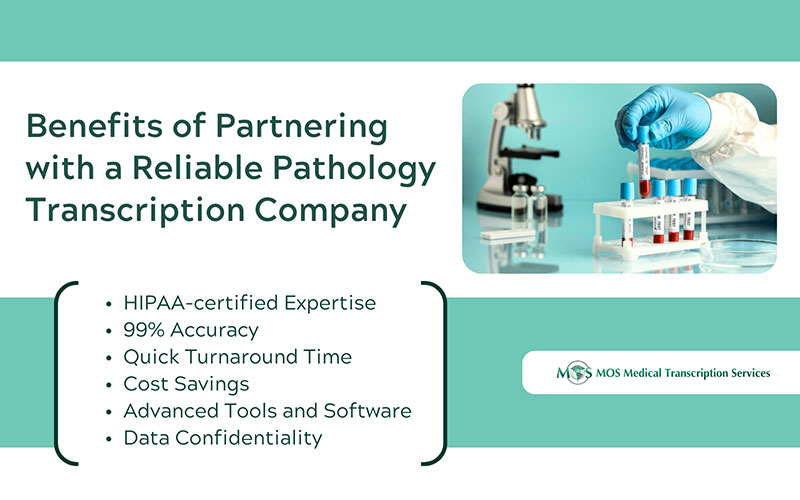Table of Contents
A pathology report is an important document that guides diagnostic and prognostic decisions. Pathology report accuracy is therefore critical to provide appropriate and high-quality patient care. Outsourcing is a practical solution to ensure this. Professional medical transcription support helps in generating error-free pathology records. Incomplete and inaccurate pathology reports can have a negative impact on patient care. Clinical research reviews show that even minor typographic errors can greatly change the meaning of a report. Let’s take a look at the types of errors that commonly occur and how these can be prevented.
Pathology errors are divided into three types according to their occurrence during the three phases of analysis such as pre-analytic, analytic and post-analytic.
Pre-analytic Errors
Common pre-analytic documentation mistakes in pathology occur during the ordering, transferring, preparing and accessioning of samples. Some of them are: obtaining the specimen from the wrong patient, providing inadequate tissue for diagnosis, and placing the specimen in the wrong fixative media. Serious errors including specimen loss, untimely delivery of a specimen, and delivery of a specimen to the wrong site can drastically affect patient care and are magnified if difficult, dangerous, or impossible to obtain suitable specimen.
Prevention Tip:
Most pre-analytic errors happen outside of a pathology lab’s control. Pathologists need to understand the context of the analysis to prevent such errors and for that clear communication is a must. Poor communication from surgeons or primary care physicians causes great confusion during accessioning and analysis. The College of American Pathologists (CAP) recommends establishing standard procedures such as mutually developed lists of acceptable abbreviations, acronyms, and symbols for better communication with the care team partner. In addition to this, pathology labs should also determine how referring physicians can deliver (and receive) reports, whether through system-to-system interfaces or standardized codes. Procedures that are unique to different physicians or wards should be established before ordering tests.
Analytic Errors
Analytic errors occur during histologic or cytologic specimen processing, in the gross room, at the microscope, and by clerical personnel in the laboratory. Histology errors include slide labeling errors and numerous problems stemming from specimen contamination, while errors in the gross room include incomplete or incorrect gross examination, poorly worded description of the gross examination of a specimen, poor or incorrect sampling of tissue for microscopic analysis, and block mislabeling. Errors at the microscope include slide mix-ups, mistakes caused by cognitive problems and poorly worded or poorly formulated reports. Mistakes in the pathology reporting process such as assignment of a report to the wrong patient, clinical and typographic errors are also critical.
Prevention Tip:
Pathologists believe they are particularly responsible for errors at the microscope as they are always directly involved in the processes. They need to be very careful during the analytical phase to prevent pathology reporting mistakes. In addition to that, it is vital to generate pathology reports that are more complete, consistent and accurate. Typographic errors in particular can be difficult to detect and it is very important to thoroughly analyze the reports generated. The report should be standardized while adapting to the specific needs of different labs, physicians and patients.
Post-analytic Errors
Post-analytic errors occur when the results of the analytic phase are communicated to the caregivers so that they can use that information for patient care. These include delivery of reports or information to the wrong clinician, untimely delivery of reports, treating physician misunderstanding the information in the report, and caregivers failing to see the report at all. Post-analytic errors are linked to the shortcomings in the previous phases. If some of these errors stem from pre-analytic labeling and accessioning error, some stem from poorly formulated reports, some relate to operational issues present in the report delivery process, and others relate to clinician office practices.
Prevention Tip:
For error-free pathology reporting, you should ensure immediate and accurate distribution of data through referring providers’ preferred methods. The use of interoperable EMRs can streamline this process. Thorough checking of pre-distribution error is a must.
Synoptic Reporting vs. Medical Transcription
Synoptic reporting or electronic medical reporting through entry of clinical data into discrete fields improves communication and workflow and is effective in preventing errors at all three phases of the pathology process. With standard structure and language, synoptic reporting prevents problems that are commonly found in dictated and narrative reporting such as typographic errors, inconsistent formats, incomplete information, and turnaround delays. Moreover, pathology templates provide the right balance of standardization and customization to generate consistently complete reports. Using the right synoptic software allows administrators to aggregate and search reports, review performance and develop quality assurance measures, which further prevent pathology report errors and ensure patient safety.
However, there are certain drawbacks with synoptic reporting. Sometimes, this reporting system may flood your pathology reports with unnecessary data fields and the advantage of time saving will quickly vanish. If the synoptic software won’t enable you to configure new data and free text fields, it can produce errors when handling complex cases. Mobility, compatibility, interoperability and user interface issues are other problems. Using the right synoptic software can help solve these issues. But if you find this option too costly and difficult to implement, EMR transcription with quality assurance can be a good choice. In this approach, pathology reports at each stage of analysis are transcribed by experienced transcriptionists. Quality control in pathology transcription ensures the reports are thoroughly checked by the quality assurance team involving proofreaders and editors, which will eliminate possible errors. Accurate data thus obtained is populated into the corresponding EMR fields. This will provide the advantage of efficiency with electronic reporting and narrative description.
How Professional Voice-to-Text Services for Physicians Ensure Accurate Pathology Transcripts
Medical transcription services play a pivotal role in accurate pathology recordkeeping. It converts complex medical jargon, findings, and diagnoses into clear, structured, and error-free reports. Expert transcriptionists, equipped with medical knowledge and a deep understanding of pathology terminology, ensure that every detail is transcribed precisely. They utilize advanced transcription tools and double-check pathology reports to ensure they are error-free.
Outsourcing transcription for pathology labs offers several advantages:
- HIPAA-certified Expertise: A skilled team with expertise in medical terminologies and report formatting ensures compliance with HIPAA regulations, safeguarding patient confidentiality.
- 99% Accuracy: Precision in transcripts is guaranteed through rigorous quality assurance processes.
- Quick Turnaround Time: Delivering reports within 24 hours ensures timely patient care and efficient operations.
- Cost Savings: Clients can save up to 30 to 40% on transcription costs, making it a cost-effective solution.
- Advanced Tools and Software: The use of state-of-the-art transcription technologies enhances efficiency and reduces errors.
- Data Confidentiality: Legal binding agreements ensure the complete confidentiality of medical records.
- Improved Efficiency: By reducing reporting errors in pathology, documentation experts improve lab documentation workflow.
Reducing reporting errors in pathology is essential for quality patient care and streamlined workflows. Professional voice-to-text services for physicians can help healthcare providers maintain high standards of documentation while optimizing time and costs. They follow the best practices to ensure error free pathology transcription.




